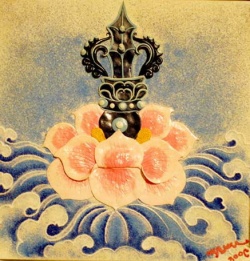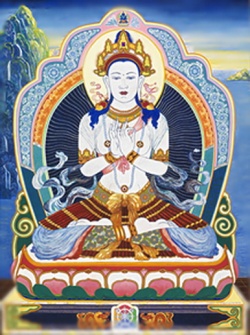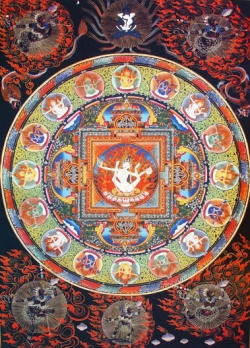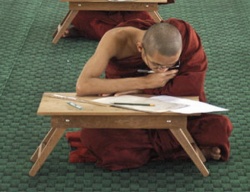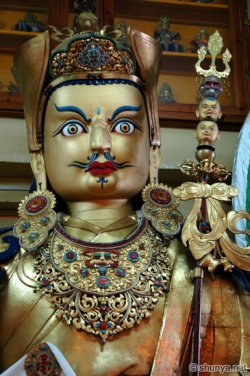Universities in ancient India
Most Indians today are well aware of the two famous ancient universities of India which also are one of the oldest universities in the world – Takshashila University (Taxila) and Nalanda. But are these the only knowledge centers that existed in ancient India? Education has always been given great prominence in Indian society since the times of the vedic civilization, with gurukul and ashrams being the centers of learning. And with evolving times, a large number of centers of learning were established across ancient India of which Takshashila and Nalanda are the most famous ones known today. Below is a list of major ancient universities that flourished across ancient India.
Nalanda University
Nalanda University was established by Shakraditya of Gupta dynasty in modern Bihar during early 5th century and flourished for 600 years till 12th century. Nalanda was the world’s first university to have residential quarters for both students and teachers. It also had large public lecture halls. Students from countries like Korea, Japan, China, Tibet, Indonesia, Persia and Turkey came to study in this university.
The library of this university was the largest library of the ancient world and had thousands of volumes of manuscripts on various subjects like grammar, logic, literature, astrology, astronomy, and medicine. The library complex was called Dharmaganja, and had three large buildings: the Ratnasagara, the Ratnadadhi, and the Ratnaranjaka. Ratnadadhi was nine stories tall and stored the most sacred manuscripts including the Prajnaparamita Sutra and the Samajguhya.
In 2010, the parliament of India passed a bill approving the plans to restore the ancient Nalanda University as a modern Nalanda International University dedicated for post-graduate research. Many east asian countries including China, Singapore and Japan have come forward to fund the construction of this revived Nalanda University.
Nalanda is mentioned in the sutras as a place where the Buddha often taught. Although some viharas may have been built on the site in the centuries after the Buddha's parinirvana, it is now generally agreed that the founding of the great university dates back to the reign of the Gupta king Kumaragupta I, who ruled from 415 to 455 and is referred to as Shakraditya (Śakrāditya) in many sources. Several monasteries were constructed on the site during the Gupta period, and at some point, possibly during the sixth century, they were enclosed within a wall with a single gate. By the time the Chinese pilgrim Hsüan-tsang visited in the seventh century, entrance to the university could only be gained by those who passed the admission test put to them by learned gatekeepers. Hsüan-tsang stayed for a period of about six years, during which he studied Yogachara philosophy. I-tsing (635-713), another Chinese pilgrim, who visited after Hsüan-tsang and stayed for about ten years, reports that there were about 3500 monks in residence at that time.
The biography of Chak Lotsawa explains how he visited the site, then largely in ruins, in 1235 AD. While there, he studied with the master Rahula Shribhadra, a specialist in Sanskrit grammar who was in his nineties and was teaching a class of about seventy students. The biography includes a moving account of how, on one occasion, the lotsawa was forced to carry his aged teacher on his back in order to flee a band of 300 Muslim soldiers after everyone else had fled the monastery.
Nalanda may not be the oldest institution but is one of oldest when civilization picked up.
"A great Buddhist monastery which was located seven miles to the north of Rajgir, in Bihar, India. As a center of Buddhist study, particularly of Madhyamika philosophy, it prospered from the fifth through twelfth centuries. It was founded in the fifth century by Kumaragupta (r. 414-455), king of the Gupta dynasty, also called Shakraditya. Thereafter, the monastery was enlarged by the kings of the late Gupta period. The Nalanda Monastery was in reality a Buddhist university, where many learned monks came to further their study of Buddhism. Hsuan-tsang and I-ching, Chinese priests who traveled to India in the seventh century, wrote of the imposing structure and prosperity of this monastery. Many outstanding Mahayana Buddhist scholars such as Sharmapala and Shilabhadra studied at the Nalanda Monastery."
"Buddhist university in India, founded initially as a monastery by Sakraditya, king of Magadha. Harsavardhana of Kanauj (A.D. 606-647), a great patron of Buddhism, donated revenue of a hundred villages for the maintenance of this great establishment. It was a great center of Mahayana thought, noted for its extensive library and its congregation of Madhyamika scholars. Not only was it a home for famous Buddhist teachers like Dignaga, but it was also a place of learning attractive to visiting pilgrims. Scholars like Hsuan-tsang and I-ching studied there before returning to China with texts and teaching. It eventually became something of a pipeline for exporting Buddhist ideas and scholars to Tibet, an association which dramatically influenced Tibetan Buddhism for centuries. Nalanda was eventually destroyed by Muslim invaders."
"Nalanda lies 7 miles to the north of Rajgir. Nalanda Mahavihara by this time became the premier Buddhist institution not only in India, but its prestige as an educational center of supreme importance became known throughout the Buddhist world. Its fame and honor continued till the end of the twelfth century... During the time of the Pala Rulers (eighth to twelfth century) Nalanda rose to ever greater prosperity and fame. One of the luminaries of the university, Padmasambhava, went to Tibet and founded Tantrism there."
Takshashila University
Taxila as it is called today, Takshashila University established around 2700 years ago was home to over 10500 students where the students from all across the world used to come to attain specialization in over 64 different fields of study like vedas, grammar, philosophy, ayurveda, agriculture, surgery, politics, archery, warfare, astronomy, commerce, futurology, music, dance, etc. Famous graduates of this University include the ones like Chanakya, Panini, Charaka, Vishnu Sharma, Jivaka etc. This is the world’s oldest university.
More than 2700 years back a huge university existed in that ancient India where over 10,500 students from all across the world came for higher studies.
This was the TakshaShila university of ancient India (wrongly spelled as Taxila today). During its times this university was the IIT and MIT of the world, where the students from all across the world used to come to attain specialization in over 64 different fields of study like vedas, grammar, philosophy, ayurveda, agriculture, surgery, politics, archery, warfare, astronomy, commerce, futurology, music, dance, etc. There were even curious subjects like the art of discovering hidden treasure, decrypting encrypted messages, etc
Students were admitted to this university at the age of 16 after they had completed their basic education in their local institutions. Every single graduate who passed out of this university would become a well sought after scholar all across the subcontinent!
Admission into this university was purely based on merit. The students would opt for electives and then would do indepth study and research into their field of choice.
Some of the students who graduated out of the Takshashila university included the great political master Chanakya (also called Kautilya/Vishnugupta who not only authored the world’s finest work till today on political duties, statecraft, economic policies, state intelligence systems, administrative skills and military strategy, called the Artha Shastra which consists of 15 books, but who also guided Chandragupta Maurya as a mentor who founded the Great Mauryan Empire, and also served as the prime minister of the Mauryan Empire!)
I think Nalanda university was also as old as Takshashila.
Vikramashila University
Vikramashila University was established by Dharmapala of Pala dynasty during late 8th century and flourished for 400 years till 12th century. It was located in the Bhagalpur district of modern day Bihar. It gave direct competition to Nalanda University with over 100 teachers and over 1000 students listed in this University. This university was well known for its specialized training on the subject of Tantra (Tantrism). One of the most popular graduates from this University was Atiśa Dipankara, a founder of the Sharma traditions of Tibetan Buddhism who also revived the Buddhism in Tibet.
Valabhi University
Valabhi University was established in Saurashtra of modern Gujarat at around 6th century and it flourished for 600 years till 12th century. Chinese traveler Itsing who visited this university during the 7th century describes it as a great center of learning. Gunamati and Sthiramati, the two famous Buddhist scholars are said to have graduated from this University. This University was popular for its training in secular subjects and students from all over the country came to study in this University. Because of its high quality of education, graduates of this University were given higher executive posts.
Pushpagiri University
Pushpagiri University was established in ancient Kalinga kingdom (modern day Odisha) and was spread across Cuttack and Jajpur districts. It was established in 3rd century and flourished for the next 800 years till 11th century. The university campus was spread across three adjoining hills – Lalitgiri, Ratnagiri and Udayagiri. This was one of the most prominent centers of higher education in ancient India along with the universities of Takshashila, Nalanda and Vikramashila. The Chinese traveler Xuanzang (Huien Tsang) visited this university in 639 CE. Lalitgiri is said to have been commissioned by early 2nd century BCE itself and is the oldest Buddhist establishments in the world. Recently a few images of Emperor Ashoka have been discovered here, and it has been suggested that the Pushpagiri University was established by Emperor Ashoka himself.
Odantapuri University
Odantapuri University was established by Dharmapala of Pala dynasty during late 8th century in Magadha (which is in modern day Bihar) and flourished for 400 years till 12th century. The famous Acharya Sri Ganga who was a professor at the Vikramashila University was a graduate of this Odantapuri University. According to the ancient Tibetan records there were about 12,000 students studying at this University. Ancient Tibetan texts mention this as one among the five great Universities of its time, the other four being Vikramashila, Nalanda, Somapura and Jagaddala Universities – all located in ancient India.
Somapura University
Somapura Mahavihara was established by Dharmapala of Pala dynasty during late 8th century in Bengal and flourished for 400 years till 12th century. The University spread over 27 acres of land of which the main complex was 21 acres was one of the largest of its kind. It was a major center of learning for Bauddha Dharma (Buddhism), Jina Dharma (Jainism) and Sanatana Dharma (Hinduism). Even today one can find ornamental terracotta on its outer walls depicting the influence of these three traditions.
Other Ancient Universities
The above mentioned list is not a complete list of ancient Indian universities either. Dharmapala of Pala dynasty alone is said to have established 50 mega learning centers across his kingdom, and they have been as huge and as popular as the ones mentioned above. For instance, the Munshiganj Vihara discovered as recently as Marh 23, 2013 in Bengal is said to have been established in 9th century and was home to 8000 students who came from faraway places like China, Tibet, Nepal and Thailand.
Destruction of Ancient Indian Universities
As you can see, many of the universities mentioned above came to an end around 12th century. The universities like Nalanda, Vikramashila etc were destroyed around this period during the Muslim invasion of India by the fanatic Bakhtiyar Khilji from Turkey in 1193 CE. The great library of Nalanda University was destroyed, ransacked and burnt by the soldiers of Khilji’s army and it is said that it was so vast that the manuscripts kept burning for three months. In-numerous number of ancient Indian manuscripts carefully preserved for thousands of years were destroyed in this fire. Thousands of monks in the University were burnt alive and beheaded by Khilji’s army. According to DC Ahir, the destruction of these centres of learning at Nalanda and other places across northern India was responsible for the demise of ancient Indian scientific thought in mathematics, astronomy, alchemy, and anatomy.
Most Indians today are well aware of the two famous ancient universities of India which also are one of the oldest universities in the world – Takshashila University (Taxila) and Nalanda. But are these the only knowledge centers that existed in ancient India? Education has always been given great prominence in Indian society since the times of the vedic civilization, with gurukul and ashrams being the centers of learning. And with evolving times, a large number of centers of learning were established across ancient India of which Takshashila and Nalanda are the most famous ones known today. Below is a list of major ancient universities that flourished across ancient India.
Nalanda University
Nalanda University was established by Shakraditya of Gupta dynasty in modern Bihar during early 5th century and flourished for 600 years till 12th century. Nalanda was the world’s first university to have residential quarters for both students and teachers. It also had large public lecture halls. Students from countries like Korea, Japan, China, Tibet, Indonesia, Persia and Turkey came to study in this university.
The library of this university was the largest library of the ancient world and had thousands of volumes of manuscripts on various subjects like grammar, logic, literature, astrology, astronomy, and medicine. The library complex was called Dharmaganja, and had three large buildings: the Ratnasagara, the Ratnadadhi, and the Ratnaranjaka. Ratnadadhi was nine stories tall and stored the most sacred manuscripts including the Prajnaparamita Sutra and the Samajguhya.
In 2010, the parliament of India passed a bill approving the plans to restore the ancient Nalanda University as a modern Nalanda International University dedicated for post-graduate research. Many east asian countries including China, Singapore and Japan have come forward to fund the construction of this revived Nalanda University.
Takshashila University
Taxila as it is called today, Takshashila University established around 2700 years ago was home to over 10500 students where the students from all across the world used to come to attain specialization in over 64 different fields of study like vedas, grammar, philosophy, ayurveda, agriculture, surgery, politics, archery, warfare, astronomy, commerce, futurology, music, dance, etc. Famous graduates of this University include the ones like Chanakya, Panini, Charaka, Vishnu Sharma, Jivaka etc. This is the world’s oldest university.
Vikramashila University
Vikramashila University was established by Dharmapala of Pala dynasty during late 8th century and flourished for 400 years till 12th century. It was located in the Bhagalpur district of modern day Bihar. It gave direct competition to Nalanda University with over 100 teachers and over 1000 students listed in this University. This university was well known for its specialized training on the subject of Tantra (Tantrism). One of the most popular graduates from this University was Atiśa Dipankara, a founder of the Sharma traditions of Tibetan Buddhism who also revived the Buddhism in Tibet.
Valabhi University
Valabhi University was established in Saurashtra of modern Gujarat at around 6th century and it flourished for 600 years till 12th century. Chinese traveler Itsing who visited this university during the 7th century describes it as a great center of learning. Gunamati and Sthiramati, the two famous Buddhist scholars are said to have graduated from this University. This University was popular for its training in secular subjects and students from all over the country came to study in this University. Because of its high quality of education, graduates of this University were given higher executive posts.
Pushpagiri University
Pushpagiri University was established in ancient Kalinga kingdom (modern day Odisha) and was spread across Cuttack and Jajpur districts. It was established in 3rd century and flourished for the next 800 years till 11th century. The university campus was spread across three adjoining hills – Lalitgiri, Ratnagiri and Udayagiri. This was one of the most prominent centers of higher education in ancient India along with the universities of Takshashila, Nalanda and Vikramashila. The Chinese traveler Xuanzang (Huien Tsang) visited this university in 639 CE. Lalitgiri is said to have been commissioned by early 2nd century BCE itself and is the oldest Buddhist establishments in the world. Recently a few images of Emperor Ashoka have been discovered here, and it has been suggested that the Pushpagiri University was established by Emperor Ashoka himself.
Odantapuri University
Odantapuri University was established by Dharmapala of Pala dynasty during late 8th century in Magadha (which is in modern day Bihar) and flourished for 400 years till 12th century. The famous Acharya Sri Ganga who was a professor at the Vikramashila University was a graduate of this Odantapuri University. According to the ancient Tibetan records there were about 12,000 students studying at this University. Ancient Tibetan texts mention this as one among the five great Universities of its time, the other four being Vikramashila, Nalanda, Somapura and Jagaddala Universities – all located in ancient India.
Somapura University
Somapura Mahavihara was established by Dharmapala of Pala dynasty during late 8th century in Bengal and flourished for 400 years till 12th century. The University spread over 27 acres of land of which the main complex was 21 acres was one of the largest of its kind. It was a major center of learning for Bauddha Dharma (Buddhism), Jina Dharma (Jainism) and Sanatana Dharma (Hinduism). Even today one can find ornamental terracotta on its outer walls depicting the influence of these three traditions.
Other Ancient Universities
The above mentioned list is not a complete list of ancient Indian universities either. Dharmapala of Pala dynasty alone is said to have established 50 mega learning centers across his kingdom, and they have been as huge and as popular as the ones mentioned above. For instance, the Munshiganj Vihara discovered as recently as Marh 23, 2013 in Bengal is said to have been established in 9th century and was home to 8000 students who came from faraway places like China, Tibet, Nepal and Thailand.
Destruction of Ancient Indian Universities
As you can see, many of the universities mentioned above came to an end around 12th century. The universities like Nalanda, Vikramashila etc were destroyed around this period during the Muslim invasion of India by the fanatic Bakhtiyar Khilji from Turkey in 1193 CE. The great library of Nalanda University was destroyed, ransacked and burnt by the soldiers of Khilji’s army and it is said that it was so vast that the manuscripts kept burning for three months. In-numerous number of ancient Indian manuscripts carefully preserved for thousands of years were destroyed in this fire. Thousands of monks in the University were burnt alive and beheaded by Khilji’s army. According to DC Ahir, the destruction of these centres of learning at Nalanda and other places across northern India was responsible for the demise of ancient Indian scientific thought in mathematics, astronomy, alchemy, and anatomy.

